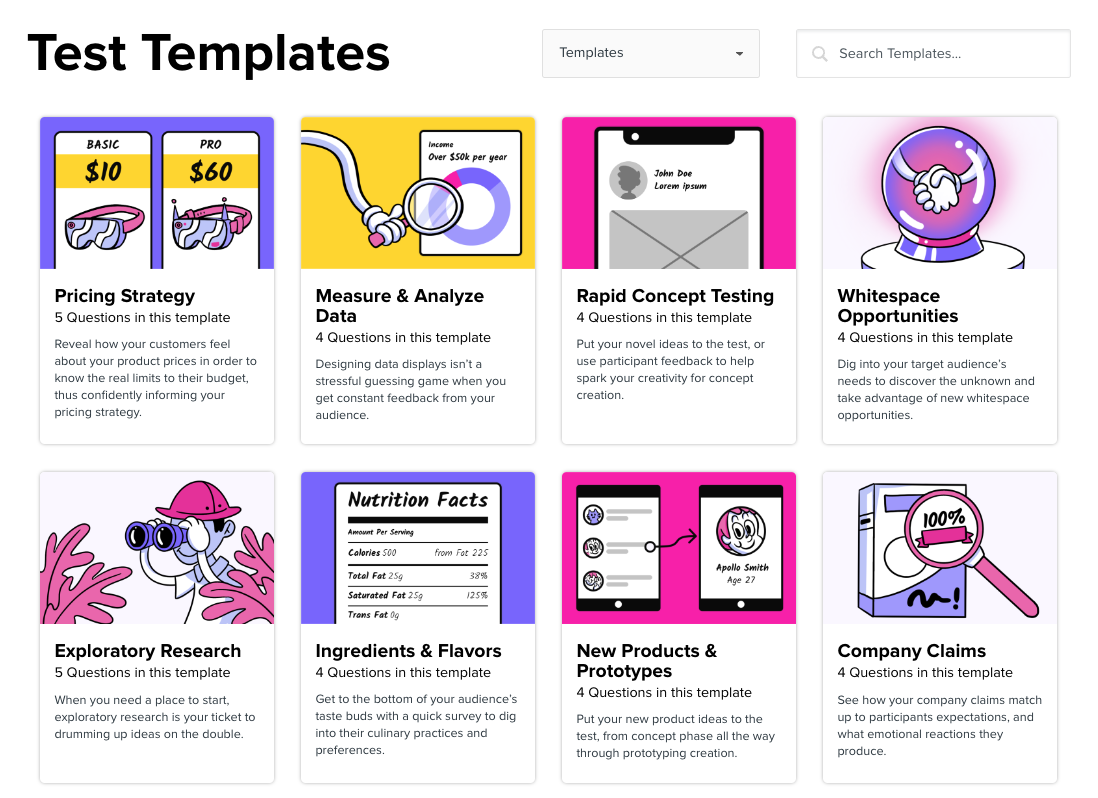What are Leading Survey Questions?
Leading questions encourage respondents to provide desired answers, potentially swaying survey data. They may intentionally guide respondents, such as choosing between two products, or unintentionally influence responses. You can ask effective survey questions without compromising audience trust or data integrity by making small tweaks to your questions.
🔩 The Nuts and Bolts:
- Understanding leading questions and how to avoid them is important for creating effective surveys.
- Types of leading questions include assumption-based, coercive, direct-implication, and interconnecting statement questions.
- Loaded questions also should be avoided as they mislead respondents while providing possible favorable feedback for the creator.
- Leading and loaded questions should be avoided to maintain data integrity, gain new insights, and provide actionable data points.
As a survey creator, you need insights to take action on. But what if you unknowingly ask leading questions that sway respondent’s answers in a favorable way? Asking leading questions can harm your survey program, providing unhelpful and misleading results. We’ll explore leading questions, different types, the difference between leading and loaded questions, and why you should avoid them altogether for improved surveys.
Types of leading questions with examples:
- Biased assumptions: “Don’t you agree that our service is superior?”
- Loaded questions: “How much did you enjoy our amazing service?”
- Double-barreled questions: “Do you find our app user-friendly and engaging?”
Understanding and avoiding leading questions can help you gather accurate insights to inform decision-making.
Subscribe to Closing the Gap
A newsletter to help makers and doers get closer to customers. Learn more.
We believe in protecting your data. Here’s our Privacy Policy.
Survey Leading Questions with Examples
Let’s dive right into the five types of leading questions so you can easily identify and avoid them when creating future surveys.
1. Coercive leading questions
These questions force respondents to answer in only one way, typically in the affirmative.
Here are some examples:
- You plan to remain working for this organization, right?
- Our customer success team responded quickly to your needs, didn’t they?
2. Direct-implication leading questions
These questions suggest future behavior to the respondent, even if they weren’t initially thinking that way.
Here are some examples:
- Would you recommend it to your friends if you enjoy playing for this team?
- Your purchase means a lot to us. Will you recommend it to others?
3. Questions that lead with interconnected statements
This type of leading question confuses respondents by making a statement and then asking a follow-up question. Be mindful of double-barreled questions and interconnected statements, as they reduce the clarity of your survey questions and may affect the quality of responses.
Here are some examples:
- Most employees want to return to the office. Do you feel similar?
- Our customers rave about this mobile app. Can’t you see why?
4. Assumption-based leading questions
These questions assume something about the respondents. They are commonly used in surveys to evaluate perceptions of products, services, or experiences. However, assumptions should be avoided as they limit respondents’ ability to express their thoughts or opinions. Include appropriate options, including neutral or “other” options to avoid bias.
Here are some examples:
- How great is your new purchase? (Here, it is assumed that the respondent enjoys their purchase.)
- How did you find our webinar? (Here, it is assumed that the respondent considered the webinar exciting.)
5. Scale-based leading questions
Watch out for scale-based leading questions! These sneaky questions are designed to sway you in a certain direction. They use a scale weighted with more positive options, making it biased. You’ll see these types of questions on all kinds of surveys.
Here’s an example:
How happy were you with our services?
🌟 Extremely satisfied
👌 Satisfied
😐 Somewhat satisfied
😕 Somewhat dissatisfied
😔 Dissatisfied
Remember to stay alert when answering surveys and watch for those tricky scale-based leading questions!
Survey Creation 101
What’s the difference between leading and loaded questions?
You might come across terms like “loaded questions” and “leading questions” that you should avoid when asking questions. But what’s the difference between them?
Leading questions direct people to a certain answer, while loaded questions are kind of like tricky questions. They make assumptions about the person being asked. In a survey, people might give favorable answers to the company, regardless of whether they agree or disagree.
Here are some examples of loaded questions:
- Where do you enjoy eating? (Here, it’s assumed the respondent enjoys eating, even if they do not.)
- How does this company make you feel like you belong? (Here, it’s assumed the respondent feels a sense of belonging, whereas they may not.)
Drive your marketing research forward with Helio
Get insights from your target audience in minutes
Why you should avoid leading questions in your surveys
If you want to maintain the integrity of your survey responses, it’s important to steer clear of leading questions – and loaded questions, for that matter. Here are a few reasons why:
- You might not learn anything new
When surveying your customers, you want to gain insights into their thoughts about your website, product, service, or any other aspect of your business. These insights can help you target the right audience, attract and retain customers, and improve your overall business operations.
However, if you ask leading questions in your customer satisfaction surveys, you may not gain any new information about your business. Why? Because you’re guiding customers to answer in a predetermined manner, essentially providing you with responses you could have written yourself!
Even if unintentional, this approach wastes both your and your customers’ time, as it yields no new or actionable insights.
- You might gather false information
Receiving false feedback can be even worse than not learning anything new from customer responses. False information can lead to misunderstandings about your customers’ experiences and how your product or service is perceived in the market.
This can ultimately result in business decisions that are detrimental rather than beneficial. This is why including neutral response options in your surveys is crucial! - You might not be able to use the data
Leading questions naturally lead survey respondents to provide intended – and often favorable – results, avoiding neutrality. This can lead to unreliable answers, introduce unwanted bias in your data, and render your research unusable.
Creating surveys that yield insightful and actionable data should be a straightforward process. However, sometimes the way questions are asked unintentionally introduces bias. By thoughtfully avoiding leading questions and overall bias in your survey design, you’ll gather more valuable data that will enable you to drive better experiences for your customers and employees – and ultimately achieve better outcomes for your business.
Avoid leading questions on your surveys to ensure accurate and valuable feedback. While some argue that these questions serve specific purposes, they can introduce bias and misleading responses. By framing questions to influence respondents towards a desired answer, you compromise the validity of your survey results. Additionally, relying on false feedback hinders your organization’s growth and improvement. Don’t risk skewed data and unreliable impressions – choose unbiased survey questions for better insights.
🚀 If you’re using Helio
Use our Test Templates to quickly launch surveys based on pre-set structures.

Helio provides over 50 Test Template structures, from Competitor Analysis to Name and Logo Testing.
Conclusion
Leading questions are sneaky survey tricks that make people answer how the survey creator wants. However, these questions complicate the results and make the survey unreliable. So, if you want a legit and trustworthy survey, stay away from leading questions.
Are you ready to make an awesome survey without any tricky questions? Get started now with Helio. Our surveys look amazing, are safe, and work great on any device!
FAQs
Leading questions encourage respondents to provide desired answers, potentially swaying survey data. They may intentionally guide respondents, such as choosing between two products, or unintentionally influence responses.
A: Types of leading questions include assumption-based, coercive, direct-implication, and interconnecting statement questions. Loaded questions also should be avoided as they mislead respondents while providing possible favorable feedback for the creator.
A: Leading questions direct people to a certain answer, while loaded questions are tricky. They make assumptions about the person being asked. In a survey, people might give favorable answers to the company, regardless of whether they agree or disagree.
A: Leading questions should be avoided to maintain data integrity, gain new insights, and provide actionable data points. Asking leading questions can harm your survey program, providing unhelpful and misleading results.
Leading questions encourage respondents to provide desired answers, potentially swaying survey data. They may intentionally guide respondents, such as choosing between two products, or unintentionally influence responses.
Types of leading questions include assumption-based, coercive, direct-implication, and interconnecting statement questions. Loaded questions also should be avoided as they mislead respondents while providing possible favorable feedback for the creator.
Leading questions direct people to a certain answer, while loaded questions are tricky. They make assumptions about the person being asked. In a survey, people might give favorable answers to the company, regardless of whether they agree or disagree.
Leading questions should be avoided to maintain data integrity, gain new insights, and provide actionable data points. Asking leading questions can harm your survey program, providing unhelpful and misleading results.












